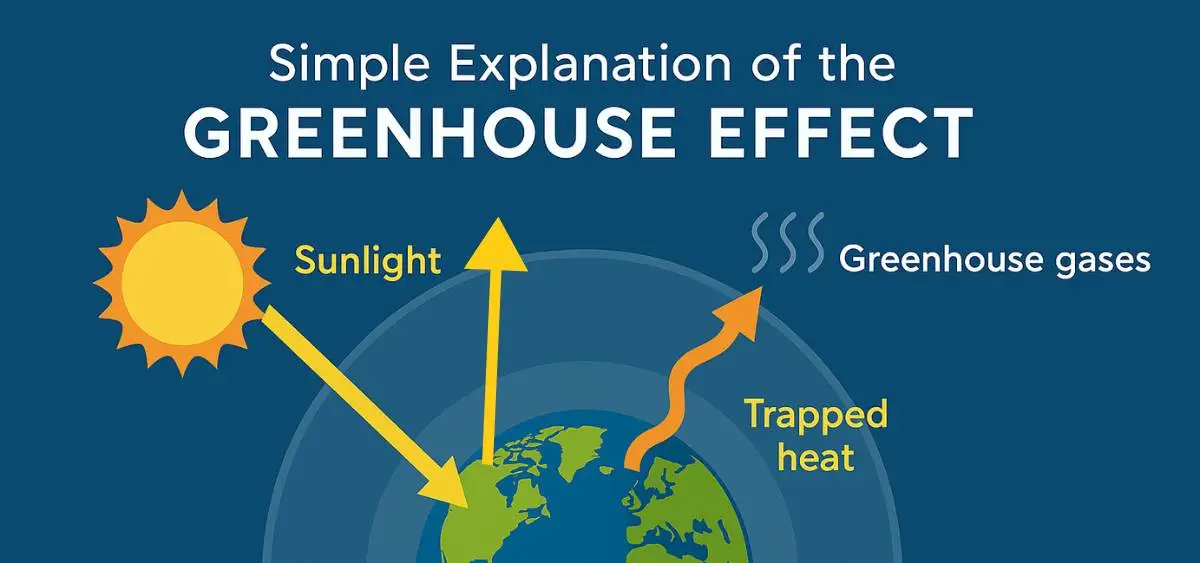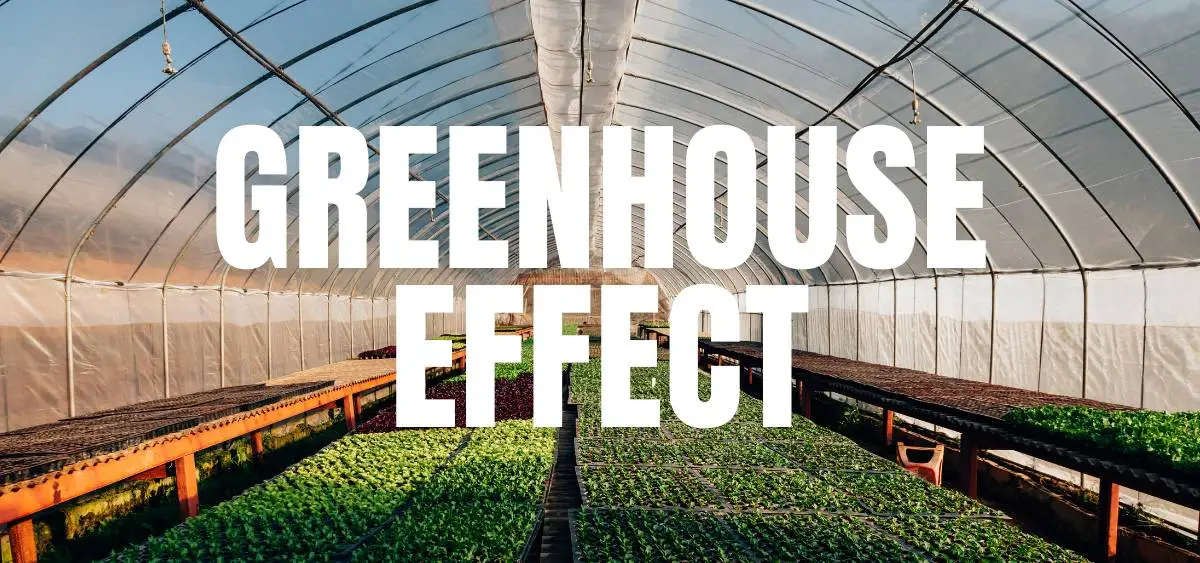Have you ever wondered why Earth is getting hotter each year? summers feel more hot than ever before, or why are glaciers melting? The answer lies in something called the Greenhouse Effect—a natural process that’s now dangerously out of balance. Let’s break it down in simple words.
Also, read: The Truth About Climate Change: What They’re Not Telling You
What Is the Greenhouse Effect?
The greenhouse effect is a natural process that helps keep our planet warm enough to support life. It works like a blanket around Earth.
Here’s how it happens: The Sun sends energy to Earth. Some of it is absorbed by the land and oceans, while some is reflected back into space. But certain gases in the atmosphere trap a portion of this heat and keep it from escaping. These are called Greenhouse Gases.
Without this natural process, Earth’s average temperature would be around -18°C. Thanks to the greenhouse effect, we enjoy a livable 15°C on average.
Also, read: Global Crisis! Impact of Climate Change Are Worse Than Expected
How the Greenhouse Effect Works
Let’s simplify this with a greenhouse effect explanation in everyday terms:
- Sunlight reaches the Earth’s atmosphere.
- Earth surface absorbs the sunlight and warms up.
- Some of this heat tries to go back into space.
- Greenhouse gases trap some of this outgoing heat.
- The trapped heat keeps the planet warm.
According to NASA, carbon dioxide levels have risen over 50% since pre-industrial times. That’s a massive shift, and it’s driving unprecedented climate change across the globe.

Also, read: The Incredible Benefits of Gardening for Just One Hour a Day
Causes of the Greenhouse Effect
There are natural and human-made causes behind the greenhouse effect.
1. Natural Causes:
- Volcanic eruptions– When volcanoes erupt, they release gases (like carbon dioxide) into the atmosphere.
- Forest fires– Even natural wildfires send carbon dioxide into the air.
- Natural carbon cycle processes– Earth naturally releases and absorbs carbon through oceans, plants, and animals. This balance keeps the climate stable.
2. Man-Made Causes (Enhanced Greenhouse Effect):
- Burning of fossil fuels– When we burn coal, oil, or gas for electricity, cars, and factories, we release a lot of carbon dioxide.
- Deforestation– Trees absorb carbon dioxide, but fewer trees mean more CO₂ stays in the air.
- Industrial emissions– Factories release all sorts of greenhouse gases into the atmosphere.
- Agriculture– Especially raising livestock like cows, which release methane, a super-strong greenhouse gas.
This man-made version is called the enhanced greenhouse effect, and it’s the primary reason behind today’s rapid climate change.
Also, read: Cigarette Butts to Adorable Creation? This Innovation Is Genius!
What Are Greenhouse Gases?
Greenhouse gases (GHGs) are gases that trap heat in Earth’s atmosphere. They include:
- Carbon dioxide (CO₂) – from vehicles, factories, and deforestation
- Methane (CH₄) – from landfills, livestock, and oil drilling
- Nitrous oxide (N₂O) – from fertilizers and combustion
- Water vapor – naturally occurring, but intensifies with warming
- Ozone (O₃) – a secondary pollutant in the lower atmosphere
These greenhouse gases examples show how both natural and human activities contribute to rising global temperatures.
Also, read: Renewable Energy: Powering a Sustainable Future
Effects of the Greenhouse Effect
The impact of the greenhouse effect is serious and widespread. Some key effects include:
- Melting ice caps and rising sea levels
- Heatwaves and record-breaking temperatures
- Extreme weather – hurricanes, floods, droughts
- Loss of biodiversity and extinction of species
- Water and food shortages
These are no longer distant problems—they’re happening now, everywhere.
Greenhouse Effect and Global Warming: What’s the Difference?
People often confuse global warming and greenhouse effect.
- The Greenhouse Effect is like a natural heating system. It’s the process where gases in the air trap some of the Sun’s heat to keep Earth warm enough for us to live. Without it, our planet would be freezing!.
- Global warming is the result—Earth’s temperature increasing over time due to too much trapped heat.
Think of the greenhouse effect as the “cause” and global warming as the “effect.”
Also, read: From Plastic to Purpose: A Thoughtful List of Sustainable Swaps
Natural vs Man-Made Greenhouse Effect
Understanding the difference between Natural vs Man-made Greenhouse Effect helps us see why human action matters.
- The Natural Greenhouse Effect– This is a good thing. It’s how Earth has stayed warm enough for millions of years to support life. Nature uses greenhouse gases (like carbon dioxide and water vapor) in just the right amount to trap heat and keep the planet comfortable—like a cozy blanket. Without it, Earth would be freezing, and life as we know it wouldn’t exist.
- The Man-made Greenhouse Effect– Now, this is where the problem starts. Humans have been burning fossil fuels, cutting down forests, and polluting the air. All of this has added way too many greenhouse gases into the atmosphere.Think of it like piling extra blankets on your bed—you get too hot, too fast. That’s what’s happening to Earth. This unnatural boost in trapped heat is leading to global warming, rising sea levels, extreme weather, and the climate crisis we face today.
Also, read: Turning Storm-Damaged Wood into Music and Hope – VAIA Cube
Solutions to the Greenhouse Effect
We’re not helpless. We can take action to prevent the greenhouse effect from getting worse:
- Reduce fossil fuel use – Instead of relying on coal, oil, and gas, we can switch to clean energy like solar, wind, or hydro power. These don’t pollute the air or trap heat like fossil fuels do.
- Plant more trees –Trees are like nature’s air filters. They absorb carbon dioxide (CO₂), one of the biggest greenhouse gases.
More trees = cleaner air and cooler planet.
- Eat sustainably – Cutting down on meat and processed food can actually reduce harmful gases like methane. Choosing more plant-based meals helps the environment and your health too.
- Support clean technology – Whether it’s solar panels, electric vehicles (EVs), or energy-efficient appliances — using or supporting clean technology reduces pollution and makes our lives more sustainable.
- Educate others – Share what you learn with friends, family, and your community. The more people understand the issue, the more likely we are to act together.
These solutions to the greenhouse effect don’t just help the planet, they protect our future.
Also, read: Zero Waste Challenge: Small Changes, Big Impact
Conclusion
The greenhouse effect is no longer just a science term—it’s a real-world issue affecting every corner of the globe. Understanding how the greenhouse effect works, its causes, and its effects is the first step toward change. By making small, smart choices, we can balance the climate scales again.
Also, read: The Dead Sea Crisis Explained: Nature’s Wonder at Risk
FAQs
1. Is the greenhouse effect bad?
The natural greenhouse effect is good. But the enhanced (extra) greenhouse effect caused by pollution is bad for the planet.
2. Can the greenhouse effect be reversed?
We can’t fully reverse it, but we can slow it down by reducing emissions and making eco-friendly choices.
3. Can planting trees help reduce the greenhouse effect?
Yes! Trees take in carbon dioxide, one of the major greenhouse gases. Planting more trees can help slow down global warming.
4. Are all greenhouse gases harmful?
Not all are harmful in small amounts. They are part of the Earth’s natural system. But too much of them, especially from human sources, is harmful.
5. What is the enhanced greenhouse effect?
The enhanced greenhouse effect is when human activities add extra greenhouse gases to the atmosphere, causing more heat to be trapped and increasing global warming.










